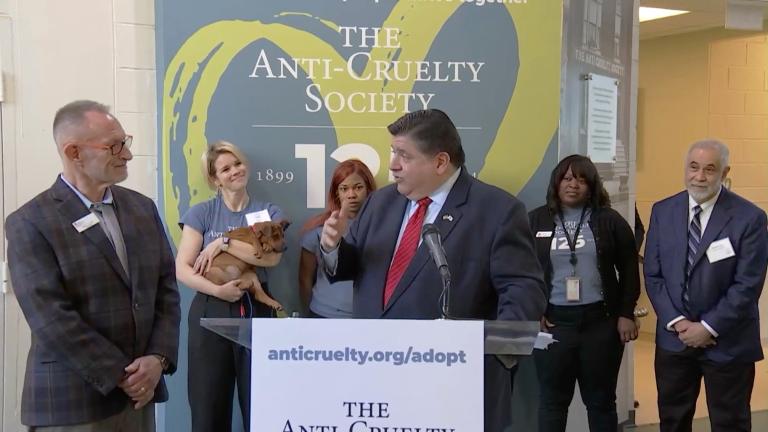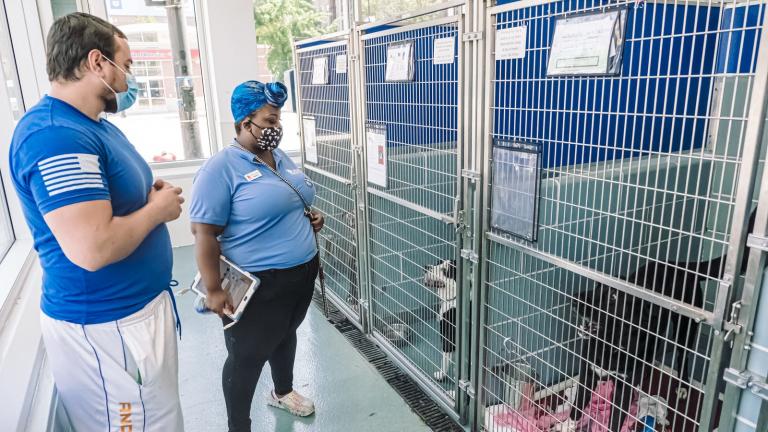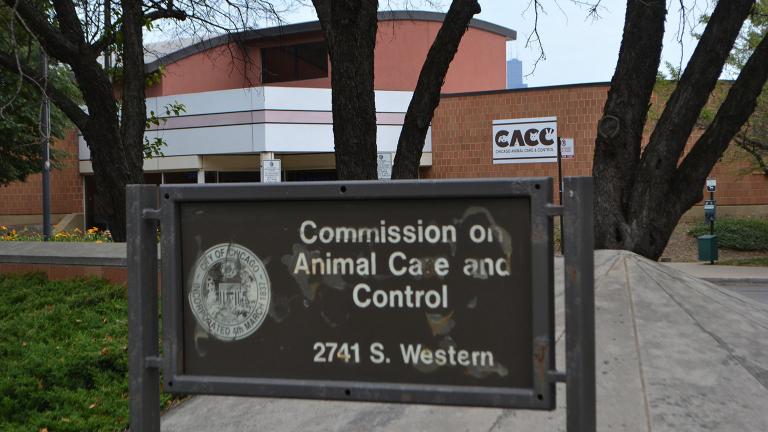Video: Susan Cappello, acting executive director of Chicago Animal Care and Control, Paula Fasseas, co-founder of PAWS Chicago, and Cynthia Bathurst, CEO and founder of Safe Humane Chicago, appear on “Chicago Tonight” on Dec. 11, 2023. (Produced by Emily Soto)
Visitors to the animal shelter at Chicago Animal Care and Control on the Lower West Side will be met with rooms of kennels filled with dogs and cats. But for many of the animals, their lives will end there.
As the city shelter sees an increase in stray animals coming through its doors since the COVID-19 pandemic, more dogs and cats that end up at the shelter are being euthanized.
“Any animal that walks through our door can be a candidate for euthanasia due to the population and everything that we go through here,” said Susan Cappello, acting executive director of the city of Chicago Department of Animal Care and Control. “This should be the last resort that anybody wants to bring any animal to.”
A WTTW News analysis of city shelter data from January 2017 through October 2023 found:
- Compared to the same time last year, the city shelter has euthanized 359 more animals, a 25% increase, so far this year for reasons related to health, behavior and/or capacity for care. The number of euthanasia cases so far this year has already surpassed the total for all of last year.
- Stray animals being taken into the city shelter are reaching new highs after a dip during the first year of the pandemic. The city shelter has seen 2,728 more strays, a 47% increase, so far this year compared to all of 2020.
The increase in euthanasia and stray animals at the city shelter aligns with similar trends shelters are seeing nationwide, according to the data-tracking organization Shelter Animals Count. Its latest report found shelters are continuing to struggle with overcapacity as they see high numbers of animals coming in and not enough animals adopted out.
A 2021 national survey found one in five U.S. households got a cat or dog during the COVID-19 pandemic. This period also offers insight into the high number of strays that both municipal and privately owned animal shelters are seeing today, shelter leaders say.
Limited access to veterinarian clinics during the pandemic, on top of difficulties with shelters hiring and keeping on veterinarians, meant fewer people were getting their pets spayed and neutered, according to PAWS Chicago CEO Susanna Wickham.
With the pandemic, there was also more backyard breeding, she added.
“In the height of the pandemic everyone wanted to adopt,” Wickham said. “Suddenly, everyone’s staying home, and something that you can do from home is breed, and so we saw a big rise in backyard breeding, and we’re seeing a lot of those animals end up in shelters now.”
Chief Operations Officer Darlene Duggan of Anti-Cruelty Society, one of the city shelter’s rescue partners, said she has seen dips in adoption rates before, like during the economic recession in 2008. This time around, adoption rates have been slow to recover, especially for large dogs, she said.
For Duggan, it’s something she is still trying to wrap her head around.
“That’s the concerning piece is that by now, I would have expected to see that number get better or correct itself and get back to baseline, and we’re just not seeing that,” Duggan said. “There is something different right now, and so whether that is generational, whether that is due to the economy or people going back to work, it still remains a mystery.”
The Critical Role of Rescue Partner Organizations, Volunteers at the City Animal Shelter
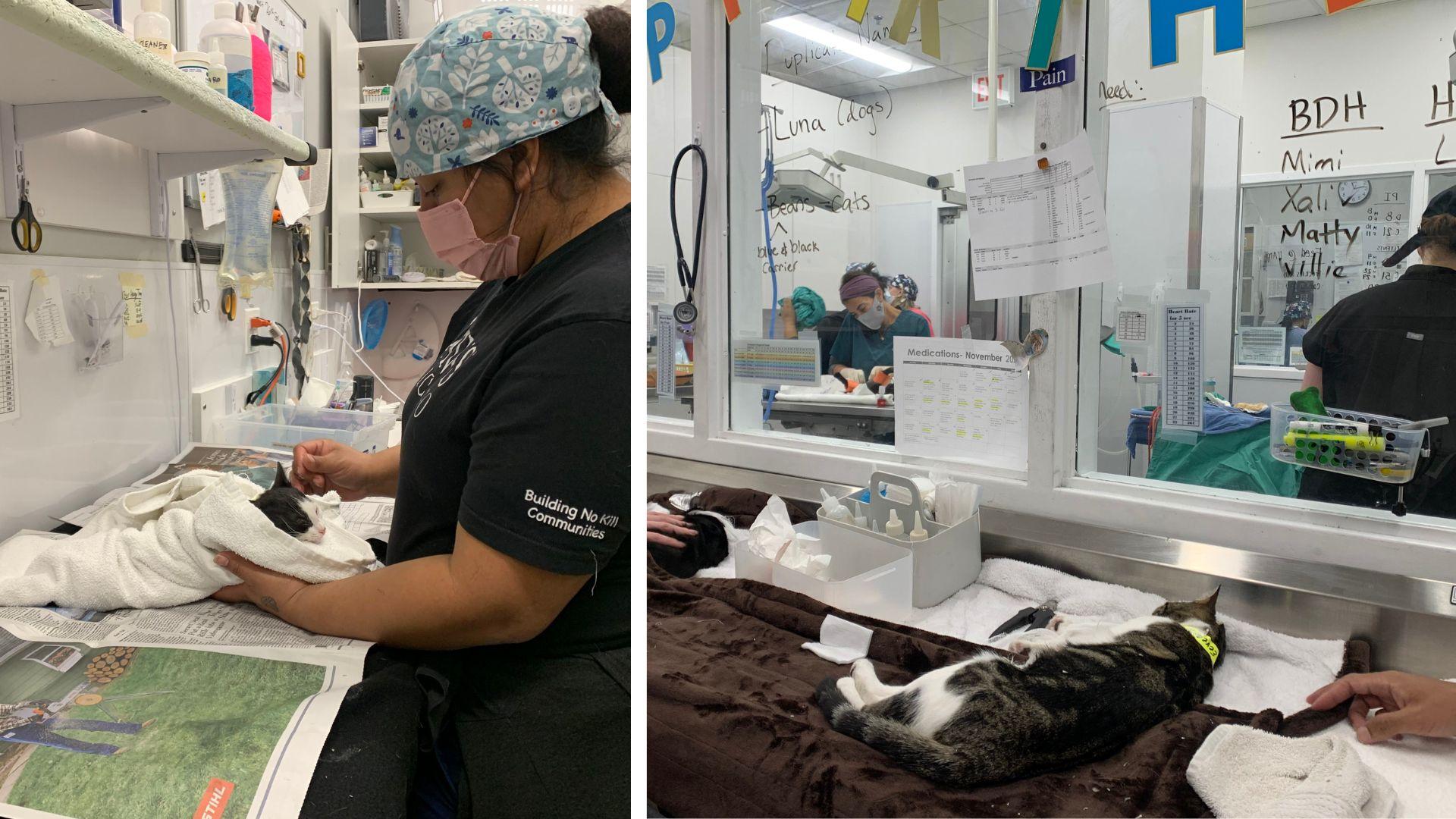 Left: A worker at PAWS Chicago wakes up a cat after surgery on Nov. 13, 2023, at PAWS Chicago Medical Center & Lurie Clinic in Little Village (Eunice Alpasan / WTTW News). Right: Multiple cats preparing for surgery and undergoing surgeries on Nov. 13, 2023, at PAWS Chicago Medical Center & Lurie Clinic. (Eunice Alpasan / WTTW News)
Left: A worker at PAWS Chicago wakes up a cat after surgery on Nov. 13, 2023, at PAWS Chicago Medical Center & Lurie Clinic in Little Village (Eunice Alpasan / WTTW News). Right: Multiple cats preparing for surgery and undergoing surgeries on Nov. 13, 2023, at PAWS Chicago Medical Center & Lurie Clinic. (Eunice Alpasan / WTTW News)
The city animal shelter works with animal rescue partner organizations across Chicago that take in animals from the shelter that might otherwise be euthanized for health or behavioral reasons or if the shelter reaches its capacity for care.
Typically, about half of the animals that come into the city shelter each year are transferred out by a rescue partner. From 2017 to 2022, that number has ranged from 6,500 animals to nearly 9,000 animals that were transferred out.
But since the pandemic, the number of animals being transferred to a rescue partner has dropped about 25% and has yet to recover back to pre-pandemic levels even as the shelter sees more stray animals coming in, according to city shelter data.
The number of active rescue partners pulling from the shelter has also decreased since the pandemic, going from over 200 rescue partners pre-pandemic to about 120 now, Cappello said, adding that some partner organizations shut down during the pandemic while others might be experiencing more animal intake at their own doors, preventing them from taking in more from the city shelter.
One of the city shelter’s major rescue partners, PAWS Chicago, was founded in response to the city shelter’s high euthanasia rates. When PAWS Chicago was established in the late 1990s, more than 90% of the animals taken into the city shelter were being euthanized.
As of last year, about 15% of the animals at the city shelter were euthanized, according to city data.
On top of taking in animals from the city shelter, PAWS Chicago follows a “no kill” model that aims to decrease euthanasia at the city shelter by offering free to low-cost spay and neuter services to address animal overpopulation and saving treatable animals through medicine and animal behavior programs.
PAWS Chicago and the city shelter recently announced an expanded partnership program that involves offering resources for Chicagoans who need help with their pets so that they can continue to keep them. The partnership also includes full-time staffing from PAWS Chicago to support the city shelter’s adoption and volunteer programs. The program was announced last month in response to the increase in euthanasia at the shelter.
In addition, the city shelter currently has about 130 active volunteers who are responsible for getting dogs out of their kennels, socializing with the animals and preparing them for adoption.
“They (the city shelter) rely on volunteers to run pretty much the entire adoption program and also to walk the dogs because they don’t have staff to get the animals out of their kennels,” said Heather Owen, executive director and founder of One Tail at a Time, one of the city shelter’s rescue partners.
The amount of time volunteers spend at the shelter can vary widely. Cappello said some volunteers might be at the shelter one day per week for two hours while another might be there three days per week for seven hours.
“There’s always a need for more (volunteers),” Cappello said.
City Shelter Volunteer, Staff and Animal Welfare Issues
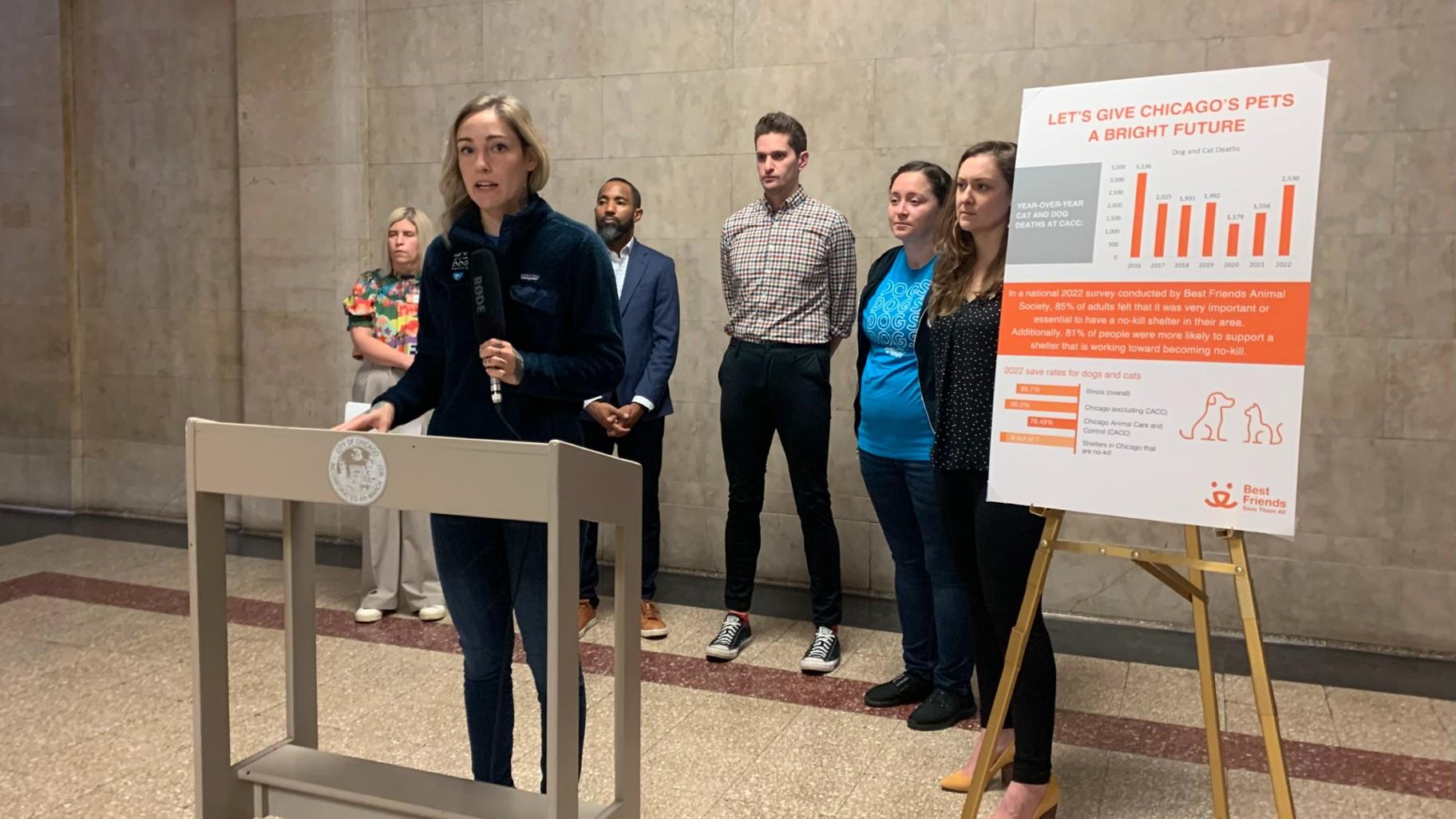 Heather Owen, executive director and founder of the rescue group One Tail at a Time, speaks during a news conference at City Hall on Nov. 6, 2023. The news conference was hosted by the nonprofit Best Friends Animal Society to raise awareness about the increase in euthanasia at the city shelter and to offer possible solutions. (Eunice Alpasan / WTTW News)
Heather Owen, executive director and founder of the rescue group One Tail at a Time, speaks during a news conference at City Hall on Nov. 6, 2023. The news conference was hosted by the nonprofit Best Friends Animal Society to raise awareness about the increase in euthanasia at the city shelter and to offer possible solutions. (Eunice Alpasan / WTTW News)
The city of Chicago Department of Animal Care and Control is expected to see a budget of nearly $7.7 million next year — an increase of more than 9% from the previous year.
Historically, funding on a per-capita basis has been lower for CACC compared to municipal shelters in other major U.S. metropolitan cities, according to Duggan.
“They have a wide range of services that they offer to the public, they take in a lot of animals, and they do it for a lot less money than is afforded to other similar municipal shelters in large cities like Los Angeles or New York or Houston,” Duggan said.
The increase in animals coming into the city shelter comes as CACC also faces challenges with filling several job vacancies.
According to Cappello, no candidates have applied for the job of veterinary medical manager, which has been vacant for more than two years. There are also vacancies for certified veterinary technicians and high turnover rates for animal care aides, who are responsible for cleaning kennels, unloading from trucks and supplying rooms with supplies, food and blankets.
“We do our interviews, we go through, and we accept people who we can, but then there’s that lengthy onboarding process that takes a little bit of time,” Cappello said. “People fall off the list because of the length of time that it takes, and that’s the unfortunate part.”
That onboarding process can include a fingerprint and background check, a debt check and a physical. The process can take several weeks to go through, Cappello said. As of Dec. 4, there were no positions with the shelter listed on the city of Chicago’s job portal.
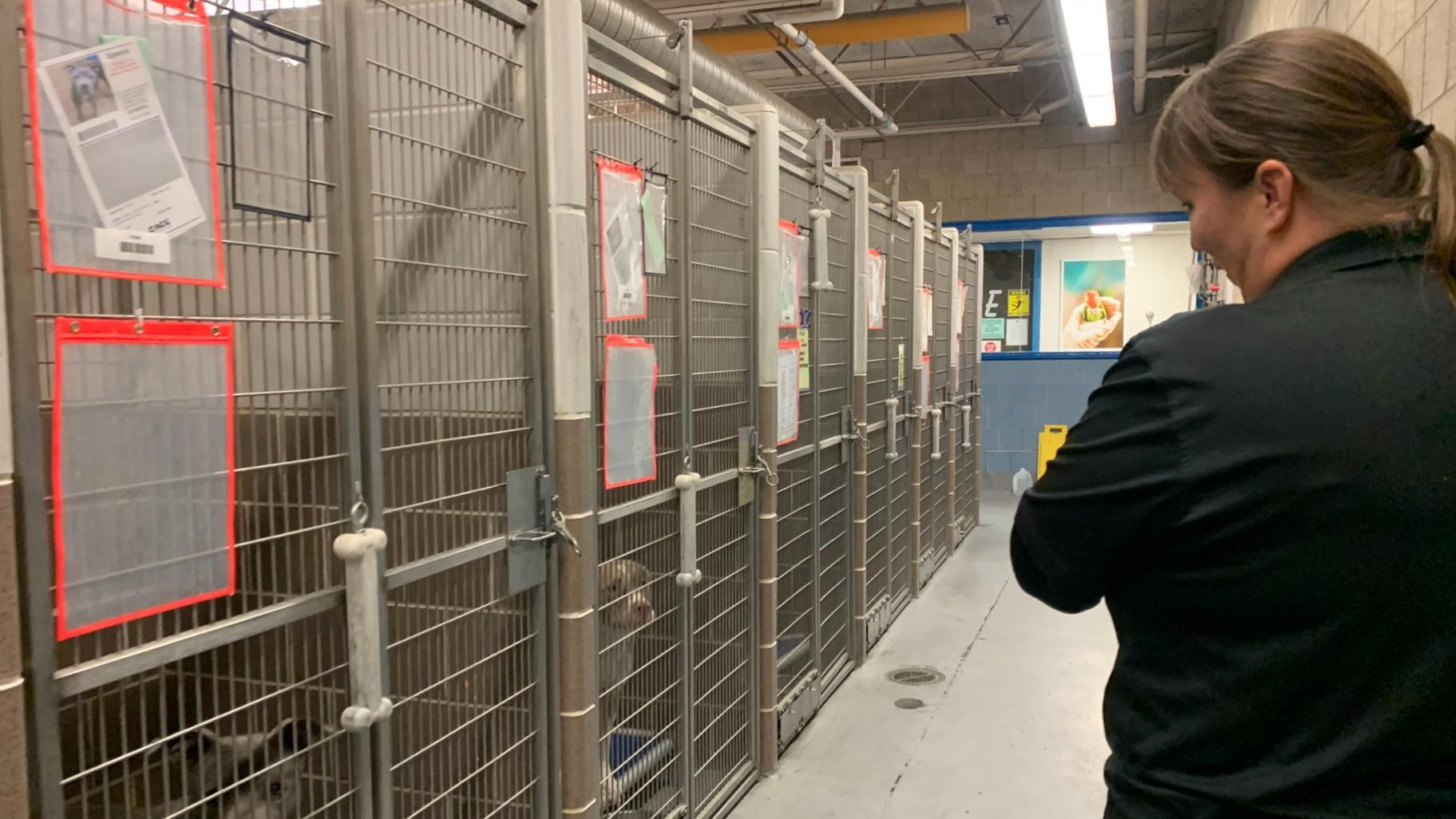 Acting executive director of the city of Chicago Department of Animal Care and Control Susan Cappello walks down an aisle of dog kennels at the city shelter on Nov. 13, 2023. CACC has had trouble filling several job vacancies and is also in need of more volunteers. (Eunice Alpasan / WTTW News)
Acting executive director of the city of Chicago Department of Animal Care and Control Susan Cappello walks down an aisle of dog kennels at the city shelter on Nov. 13, 2023. CACC has had trouble filling several job vacancies and is also in need of more volunteers. (Eunice Alpasan / WTTW News)
Similarly, the time involved in the application and onboarding process to volunteer at the city shelter can be lengthy, depending on scheduling and the availablity of staff. Volunteers are required to do a fingerprint background check and attend an informational session, training sessions and mentor sessions with other volunteers.
As the city shelter sees more animals be euthanized, increased stress among some volunteers at the shelter is a reality, according to Cynthia Bathurst, CEO and founder of the animal welfare organization Safe Humane Chicago. Many of the organization’s own volunteers also volunteer at the city shelter.
“There is no doubt that volunteers are considerably more stressed, feel more determined to help the dogs and feel sometimes frantic that we need more volunteers,” Bathurst said.
That frantic sentiment was echoed during an Oct. 25 City Council budget hearing, when a volunteer at the city shelter spoke during public comment about the stress both volunteers and staff were experiencing at the shelter.
“The volunteers quite frankly can’t keep up with the amount of dogs and cats coming in every day and socializing them and making sure they’re treated humanely,” she said, adding that animals only get to leave their cages twice per week.
On top of increased stress, some staff at the city shelter have also experienced violence while on the job.
“We’ve had instances out in the field where our field staff are experiencing gun violence,” Cappello said. “We’ve experienced an assault here in the facility by a client who came in to look for their lost pet and decided to assault one of our employees.”
The Complicated Truth About Owner Surrenders
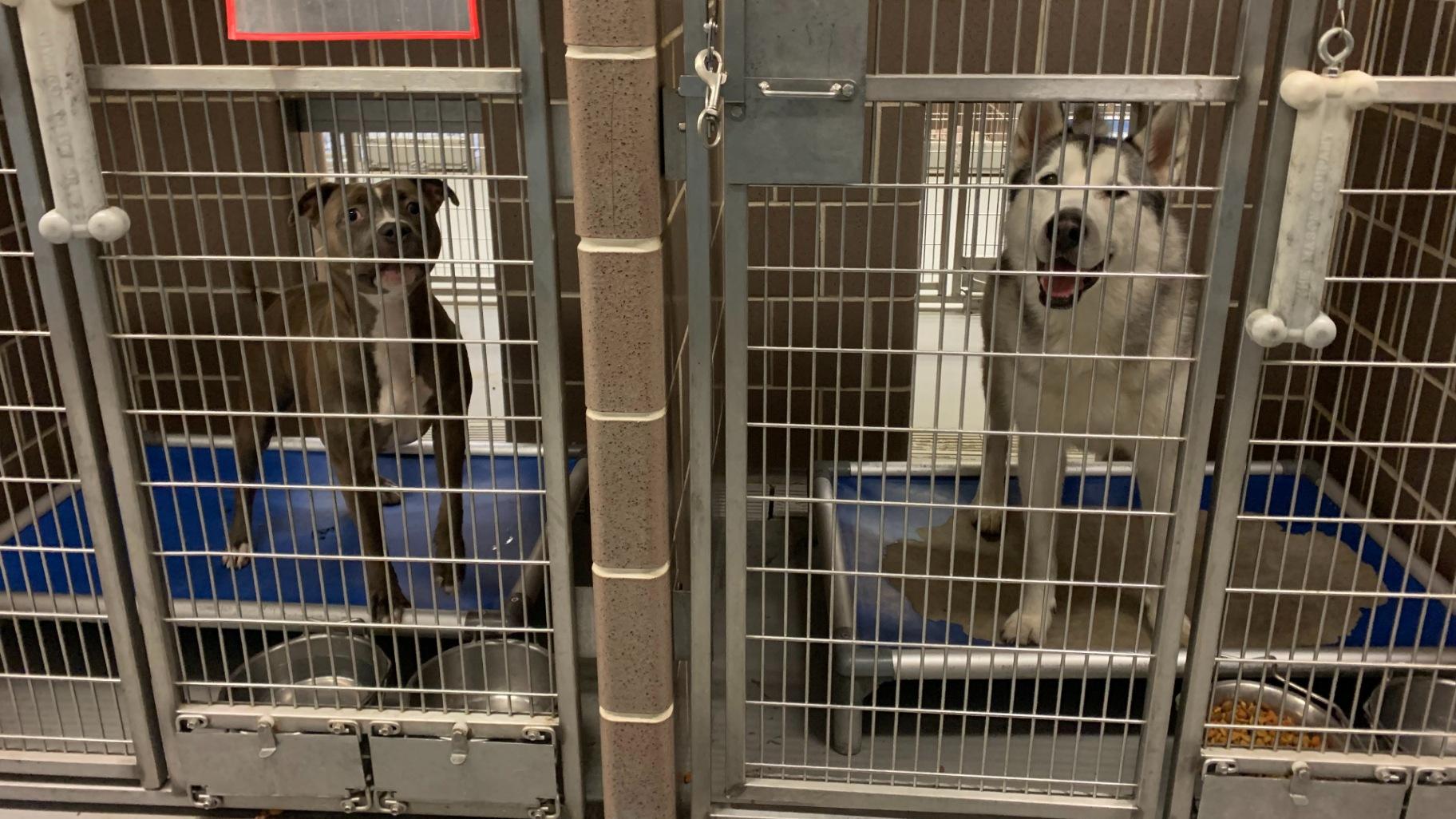 Dogs in their kennels at Chicago Animal Care and Control on the Lower West Side on Nov. 8, 2023. (Eunice Alpasan / WTTW News)
Dogs in their kennels at Chicago Animal Care and Control on the Lower West Side on Nov. 8, 2023. (Eunice Alpasan / WTTW News)
At CACC, the increase in the number of animals at the shelter is mostly being driven by stray animals as opposed to owner surrenders, according to city data.
The number of animals surrendered to the shelter has decreased by 3,400 — a 70% drop — since 2018, according to city data. Further, the number of animals surrendered is down 32% so far this year compared to the same time last year.
However, trends that appear to be good news at first glance could be indicative of a system complicated by overcapacity, according to a data analysis report by the organization Shelter Animals Count, which also found a slight dip in owner surrenders in its national data.
“This shift could suggest that some of the dogs entering shelters as strays are not actually lost, but instead are would-be owner surrenders coming in as strays,” Stephanie Filer, executive director of Shelter Animals Count, said in the data analysis report.
In other words, a decrease in owner surrenders could mean shelters are full and aren’t able to accept pets surrendered by owners or can only accept them by appointment because many shelters have to prioritize kennel space for strays due to contractual obligations, according to the Shelter Animals Count report.
That situation holds true in Chicago.
Intake of owner-surrendered pets falls outside of the city shelter's ordinance, and instead, the shelter has to prioritize stray and confiscated animals, according to a CACC spokesperson. The city shelter requires an appointment for owner surrenders, which are based on available shelter space and capacity for care.
As animal shelter leaders, workers and volunteers throughout the city face increased pressure to find placement for animals, they do so against a backdrop of barriers that prevent people from adopting, fostering or even keeping their current pets.
Some of those barriers include not being able to afford the costs of owning a pet, especially amid high inflation, in addition to housing restrictions such as no-pet policies and restrictions based on animal breed, size and weight.
The Chicagoland Rescue Intervention and Support Program is a coalition of animal rescue groups that provides low or no-cost services to help pet owners keep their pets rather than surrender them to the city shelter.
Volunteers are available at the city shelter on Saturdays to help on landlord disputes, training services, routine veterinary care, and in some cases, emergency pet care.
“When people are at the end of their rope and their only choice is to surrender to the shelter, we’re there to keep that from happening,” said Jaime Archer, a volunteer with Mutts of the Midway, one of the rescue groups in the program alongside One Tail at a Time and others.
For those who do surrender their pets, Wickham with PAWS Chicago said there’s a lot of judgment and misconceptions toward these owners and that the decision to surrender a pet is often a difficult one to make.
“We see people who really care about their pets and want to do the right thing,” Wickham said. “Sometimes the right thing is: My dog had an accidental litter, and I can't feed six dogs, I can only feed one, so I have to give this litter to a shelter.”
Finding Homes for Animals Amid Increased Pressures
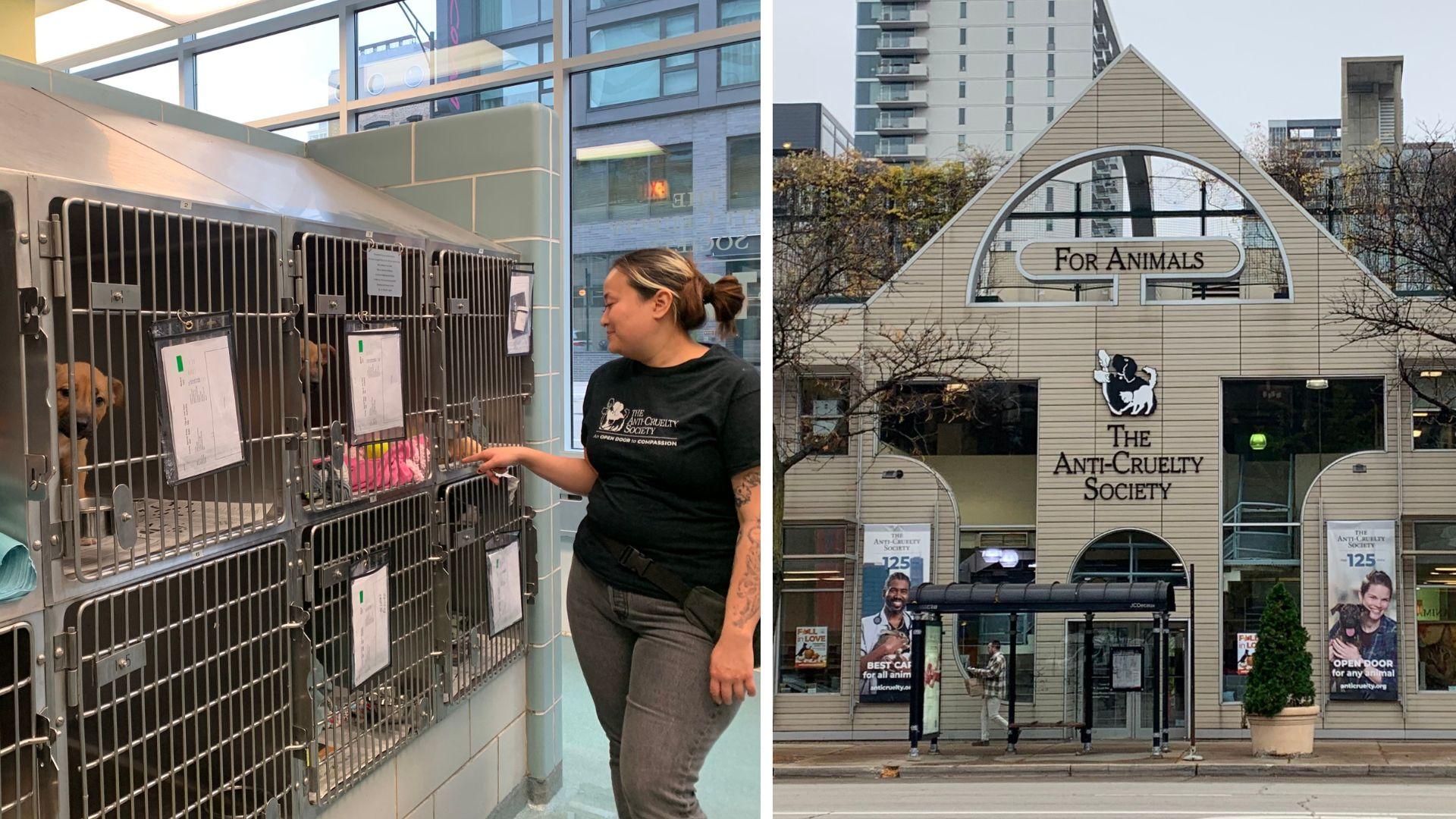 The Anti-Cruelty Society is a private, nonprofit open admission animal shelter located in River North that also serves as one of the city’s animal rescue partners. (Eunice Alpasan / WTTW News)
The Anti-Cruelty Society is a private, nonprofit open admission animal shelter located in River North that also serves as one of the city’s animal rescue partners. (Eunice Alpasan / WTTW News)
Animal shelters across the city are facing issues with the lack of adoptions to varying degrees. The Anti-Cruelty Society has had more success adopting out cats than dogs. When it comes to dogs, larger-sized dogs are the hardest to find homes for, Duggan said.
With Anti-Cruelty Society being an open admission shelter, it means that the nonprofit is also seeing its euthanasia rates go up as an increasing number of owner surrenders and stray animals come through its doors, Duggan said.
Behavioral and medical issues are factors that can influence an animal’s likelihood of being adopted, Duggan said. Another factor is interest among potential adopters in certain breeds over others.
“A lot of people are, right now at this point in time, not leaning towards adoption of pit bull or bully breed type animals, at least in our immediate area here,” Duggan said. “That’s an area that we tend to see a lot of intake from that type of animal, so it’s a struggle for us to find adoptive homes for pit bulls.”
Fighting against breed labels and stereotypes is part of the work done at Safe Humane Chicago, which advocates for dogs taken in by CACC due to abuse or neglect, Bathurst said.
Over the decades at CACC, there were periods of time when German Shepherds, Rottweilers and Labrador Retrievers were some of the most common dog breeds at the shelter. In recent years, pit bull terriers have become more prevalent. Typically, about half of the dogs today at the shelter are bully breeds.
With increased pressures facing the city shelter, some volunteers have called for more transparency from city shelter leaders regarding animals who are slated for euthanasia and how the decision gets made. Cappello said that decision varies on a case-by-case basis.
“Some of the animals do stay here for a very long period of time,” Cappello said. “I mean, how long do you really want this animal to live in these small cages? Is that really fair to the animal?”
Cappello said that she views the city shelter as a temporary holding facility for animals who shouldn’t be there for more than three to six months due to the stress animals can experience while in their kennels. She said after long periods of time in the shelter, some dogs might start spitting in their cage, some might stop eating or some might start to get sick.
For the month of November, the city shelter waived its adoption fees.
 Sonia Arrieta and Jorge Aguilar, who live in Little Village, brought along baby Natalia to Chicago Animal Care and Control on Nov. 8, 2023, and adopted a pit bull named Douglas. (Eunice Alpasan / WTTW News)
Sonia Arrieta and Jorge Aguilar, who live in Little Village, brought along baby Natalia to Chicago Animal Care and Control on Nov. 8, 2023, and adopted a pit bull named Douglas. (Eunice Alpasan / WTTW News)
It was during this time that Little Village residents Sonia Arrieta and Jorge Aguilar adopted Douglas, a gray and white pit bull that originally came into the shelter as a stray.
“My husband had a little bit of a fear of pit bulls and stuff, but this is an animal that he instantly felt like he connected with,” Arrieta said. “He touched him, and he automatically knew that this is the dog that he wanted.”
Arrieta and Aguilar filled out paperwork on seats placed along a corridor of the shelter, a makeshift waiting area as the shelter undergoes renovations. With them, Arrieta and Aguilar brought one of the newest members of their growing family: baby Natalia.
Arrieta said they were swayed to adopt at the city shelter after having looked into another animal shelter that had “a lot more absurd” requirements.
Arrieta said she and her husband have had to give up pets in the past due to housing restrictions and they held off on adopting for some time because of economic barriers during the COVID-19 pandemic that made it difficult for them to afford the costs of having a pet.
Now, their circumstances have presented an opportunity for them to have a pet again, Arrieta said.
“We feel like our family can use a little more happiness,” Arrieta said. “There’s always room for animals in our family because we really appreciate the nature that they bring: togetherness and responsibility that it teaches kids.”
Outreach and education about pet ownership and the role of the city shelter are areas city shelter leaders say they are trying to make progress on.
Some of that education involves changing people’s perceptions of the city shelter as a place where people go to first when they find a stray and instead, a last resort for animals after other efforts to find their owner in the neighborhood have been made, according to Cappello. City shelter workers also aim to remind potential adopters that owning a pet is a lifelong commitment.
“We truly need to rely on the community for adopting their pet as opposed to going out to a breeder or pet shop to find a pet,” Cappello said.
A Nov. 6 news conference hosted by the nonprofit Best Friends Animal Society aimed to raise awareness of the increase in euthanasia at the city shelter and to call on city leaders at the shelter to accept more help from other organizations and to call on elected officials to better support CACC.
Owen of One Tail at a Time said during the news conference that the city often asks a lot of its residents.
“The city asks constantly for its residents to pitch in, whether that’s keep your pet, adopt a pet, volunteer, donate, whether they’re asking rescue groups like mine to come in and take hundreds of animals a year,” Owen said. “They’re community problems and we should all do what we can, but we have to meet in the middle.”
Click here for information from PAWS Chicago about responsible pet ownership.
Note: This story was originally published on Dec. 5, 2023, and updated with video on Dec. 11, 2023.
Contact Eunice Alpasan: @eunicealpasan | 773-509-5362 | [email protected]

